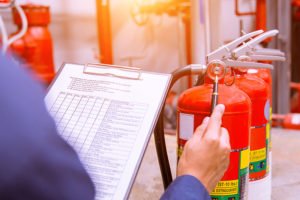The government has published new guidance on the enhanced duties of responsible persons under amendments made to the Fire Safety Order by the Building Safety Act, as Ron Alalouff reports.
The amendments to the Regulatory Reform (Fire Safety) Order 2005 made by section 156 of the Building Safety Act 2022 apply to all non-domestic premises – such as where people work, visit or stay – as well as the non-domestic parts of multi-occupied residential buildings, such as communal corridors, stairs and plant rooms.
In summary, the amendments to the Fire Safety Order require that all responsible persons must record:
- Their completed fire risk assessment in full (where previously only specific information was required to be recorded)
- The identity of the individual and/or if applicable, the organisation engaged by them to undertake/review any or all of the fire risk assessment
- Their fire safety arrangements (to demonstrate how fire safety is managed in their premises)
- Maintain their contact information and share this with other responsible persons and residents of multi-occupied residential premises, where applicable
In addition, the amended legislation requires that:
- All responsible persons take reasonably practicable steps to ascertain the existence of other responsible persons who share or have duties in the same premises, and of accountable persons (the new legal entity made under the Building Safety Act in the case of higher-risk residential buildings) for the premises – and must identify themselves to them
- Outgoing responsible persons share all “relevant fire safety information” with incoming responsible persons
- Responsible persons of a building containing two or more sets of domestic premises provide residents with relevant fire safety information, in a format that is easily understood
There is also a legislative requirement – to be brought into force at a later date – that fire risk assessors appointed by the responsible person must be competent. Guidance on this requirement will be published before it comes into force.
In the meantime, current guidance recommends that if responsible persons appoint a fire risk assessor, they should ensure that they are competent in terms of having sufficient training and experience or knowledge and other qualities.
It remains the case that the responsible person has a duty to make sure that a suitable and sufficient fire risk assessment is completed.
Duties for all responsible persons
Recording fire risk assessments in full: All responsible persons must now record the fire risk assessment and fire safety arrangements for their premises in full. This replaces the previous requirement to record only the significant findings of the fire risk assessment.
The name of the fire risk assessor and – where applicable, the name of their organisation – must also be recorded.
Cohesion with other responsible persons: The guidance highlights the importance of working with other responsible persons of the premises to help provide a cohesive approach to fire safety throughout a building.
A responsible person must take reasonably practicable steps to identify whether there are any other responsible persons for the premises. They must inform each other of the extent of their respective responsibilities under the Fire Safety Order and record this information.
It is vital that a responsible person’s fire risk assessment – and any fire safety measures taken as a result – align with and complement the fire risk assessment(s) and measures taken for the rest of the building, in order to provide a “whole building” approach to fire safety.
Identifying accountable persons: Responsible persons for higher risk residential buildings (defined under the Building Safety Act as at least 18 metres high or with at least seven storeys, and containing at least two residential units) must take reasonable steps to identify the accountable persons for the premises.
The responsible person will then need to cooperate with them to enable them to perform any duties they have under the Building Safety Act, for example, by sharing the fire risk assessment. The accountable person is likely to be the person with an obligation to repair any of the common parts of the building – typically the landlord but possibly a management company.
Providing continuity of information: Responsible persons are also required to share any relevant fire safety information with any incoming responsible person, to provide a continual record of fire safety information throughout a building’s lifetime.
This includes situations such as a business being taken over or sold, or one that ceases trading.
Buildings containing two or more sets of domestic premises

In addition to the requirements for specific instructions to be given to residents under the Fire Safety (England) Regulations 2022, responsible persons for such buildings must provide the following information to residents:
- Any risks to residents identified in the fire risk assessment
- The fire safety measures provided for any or all occupants (such as the means of escape, the measures to restrict the spread of fire and what people should do in the event of a fire)
- The name and UK address of the responsible person
- The identity of any person appointed to assist with making or reviewing the fire risk assessment
- The identity of any competent person nominated by the responsible person to implement firefighting measures
- Any risks to relevant persons throughout the building that have been identified by other responsible persons in the building
The Building Safety Act also amends two other provisions in the Fire Safety Order.
It has increased the fine for offences relating to the intentionally deceptive impersonation of a fire inspector, a failure to comply with specific requirements imposed by an inspector, and a failure to comply with requirements relating to the installation of luminous tube signs, from Level 3 (£1,000) to Level 5 (unlimited).
This aligns the level of fine possible for these offences with all other offences under the Fire Safety Order.
Finally, the Building Safety Act bolsters the weight in court proceedings of guidance published under Article 50 of the Fire Safety Order, such as the new guidance described above.
It provides that compliance with or deviation from Article 50 guidance may be relied on in establishing whether or not there was a breach of the Fire Safety Order.
Source: IFSEC GLOBAL


